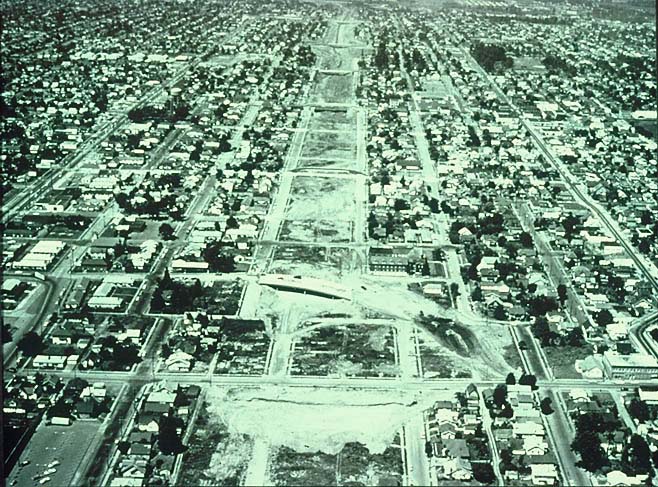War Veterans Freeway (I-205): http://en.wikipedia.org/wiki/Interstate_205_(Oregon–Washington)
I-205, or “East Portland Freeway,” now officially named the “War Veterans Memorial Freeway” is Portland’s most controversial highway. The “Interstate 50th Anniversary” project has a really good write up of it’s history.
“This 26.6-mile-long route, which meets I-5 at Tualatin south of Portland, and then continues east through West Linn and Oregon City before heading north, was one of themost delayed and controversial of Oregon’s interstate segments. It was, perhaps not coincidently, one of the first of Oregon’s highways to follow successfully the requirementsof the National Environmental Policy Act of 1969 (NEPA). NEPA required that “…roadprojects using federal funds must have an Environmental Impact Statement [EIS] detailing the effects of the proposed work,” a requirement that would have major impacts on Oregon’s interstate program. I-205 was the last of the proposed I-5 connecting loops actually to be constructed, although its final form was not as originally planned. The first contract for construction of any portion of Oregon Highway No. 64, the East Portland Freeway, as I-205 was called, was awarded on Jan. 11, 1968, for the Willamette River Bridge at West Linn. It opened to traffic on May 28, 1970. While some controversy arose during the construction of the road from I-5 east to West Linn and Oregon City, much of the 17.9 miles of this portion, perhaps among the most scenic segments of the interstate in any of Oregon’s urban areas, was completed by mid-1974. As I-205 pushed north to Multnomah County, however, the project ran into new and considerably more virulent controversy than had previously been the case. In 1973, groups opposed to the project filed petitions with Environmental Quality Commission. These environmental concerns, along with new doubts about the social value of freeways in general, put I-205 in the spotlight.
In July 1974, despite the fact that construction was already underway, the Multnomah County Board of Commissioners formally retracted its earlier approval of the I-205 route and requested that the Oregon Department of Transportation redesign a nine-mile section of the freeway. ODOT wanted to stay with the proposed eight-lane design; Multnomah County wanted no more than four lanes. The Clackamas County Board of Commissioners, who now enjoyed a virtually completed I-205 throughout the county, supported ODOT, as did the West Linn City Council. By the end of 1974, Glenn Jackson, Oregon Transportation Commission Chair, and the Multnomah County Commissioners were working on a compromise plan. Finally, in July 1975, ODOT and the local governments reached a tentative consensus that would keep the right-of-way but allow some dedication for bus only lanes while removing or redesigning several of the originally planned interchanges. But that did not end the controversy. In November 1975, the Federal Highway Administration notified the State that it objected to portions of the compromise plan related to types of interchanges and the bus-way design. By December 1975, following changes to the interchanges and redesign of portions of the bus corridor, FHWA withdrew its opposition to a six-lane I-205 freeway with exclusive buslanes, and so removed the major obstacle to construction of the route between Foster Roadand the Columbia River. By 1978-1979, construction on the remaining 9.2-mile section of I-205 was underway, with the agreement that the bus transit portion would be designed but not constructed concurrently with the route. The Glenn L. Jackson Bridge, which spans the Columbia River and connects I-205 between Oregon and Washington, was formally opened in December 1982. Interstate 205, as a complete interstate link between Tualatin and Vancouver, Wash., was completed in 1983. The controversy surrounding I-205, which questioned the focus on auto transit as opposed to bus systems or other forms of mass transit, represented a turning of the tide for freeway construction in Oregon. It was the last spur or connecting loop of I-5 to be constructed in the state.”
It is interesting to note that since this original article was written, those bus-ways have been taken over by Light Rail.
Next, Interstate Highway

